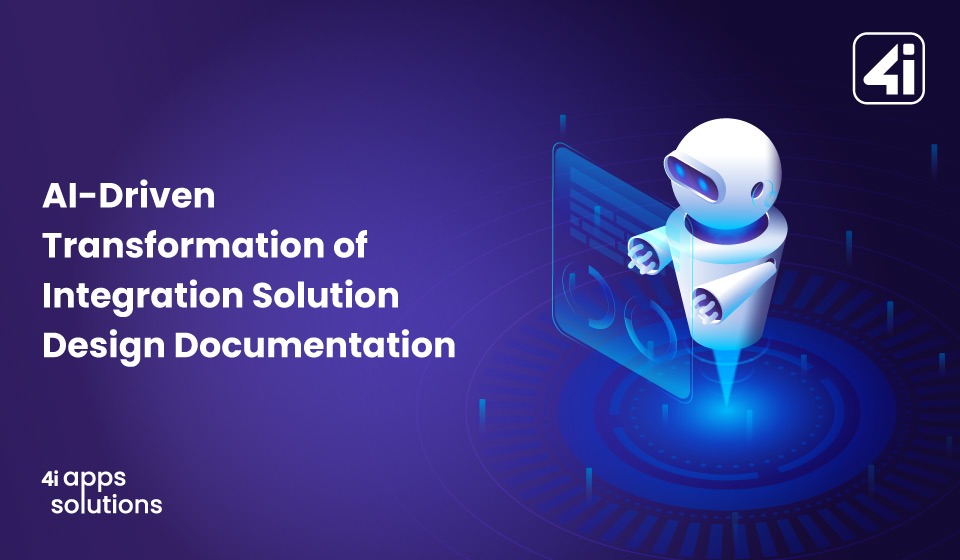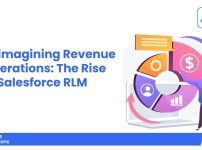AI-Driven Transformation of Integration Solution Design Documentation
Introduction
In today’s rapidly evolving technological landscape, the demand for efficient and accurate integration solutions is higher than ever. Companies increasingly rely on middleware technologies such as Oracle Integration Cloud (OIC) to bridge various enterprise applications, ensuring seamless data flow and operational continuity. However, one of the persistent challenges in this domain is the creation of comprehensive and accurate solution design documentation. This case study explores how AI-driven tools can significantly streamline the documentation process, ensuring timely delivery and enhanced accuracy.
To visually introduce the tools used in the case study:

Problem Statement
Creating solution design documentation for complex integration projects involves a multi-step process that is often manual, time-consuming, and prone to human error. Integration specialists spend significant time drafting high-level architecture diagrams, process flow diagrams, technical design documents, and use cases. This not only diverts their focus from core integration tasks but also introduces inconsistencies and inaccuracies into the documentation.
Objective
The objective of this case study is to demonstrate how AI can be leveraged to automate and streamline the documentation process for integration solution designs, with a specific focus on projects involving Oracle Integration Cloud (OIC). The goal is to reduce manual effort, improve accuracy, and ensure that documentation is consistently aligned with the integration solution being developed.
Methodology
1. AI-Powered Automation Tools
- AI–based Diagram Generation: AI tools such as Mermaid and draw.io are integrated to automate the creation of high-level architecture diagrams and process flow diagrams based on user inputs and project metadata.
- Natural Language Processing (NLP) for Documentation: AI models trained on technical language are employed to draft comprehensive technical design documents, use cases, and other necessary documentation by analysing code, user inputs, and integration scenarios.
2. Integration with Existing Middleware Tools
- Seamless Data Extraction: AI tools extract relevant data from Oracle Integration Cloud (OIC) environments, such as configuration details, code snippets, and error logs, to ensure that the documentation reflects the actual integration setup.
- Customizable Templates: AI-generated documentation is based on predefined templates that can be customized to align with the specific needs of the project and the client’s requirements.
3. Automated Updates and Consistency Checks
- Real-time Documentation Updates: As the integration solution evolves, AI tools automatically update the documentation to reflect changes, ensuring consistency and reducing the risk of outdated information.
- Error Detection and Correction: AI-driven error detection mechanisms identify inconsistencies and potential issues in the documentation, prompting users to correct them before finalization.
Use Cases
1. Use Case 1: Generating Documentation Using ChatGPT
- In this use case, ChatGPT is utilized to draft comprehensive technical design documents. The AI model analyses integration scenarios and user inputs to generate accurate and detailed documentation, including descriptions, configurations, and error handling processes.
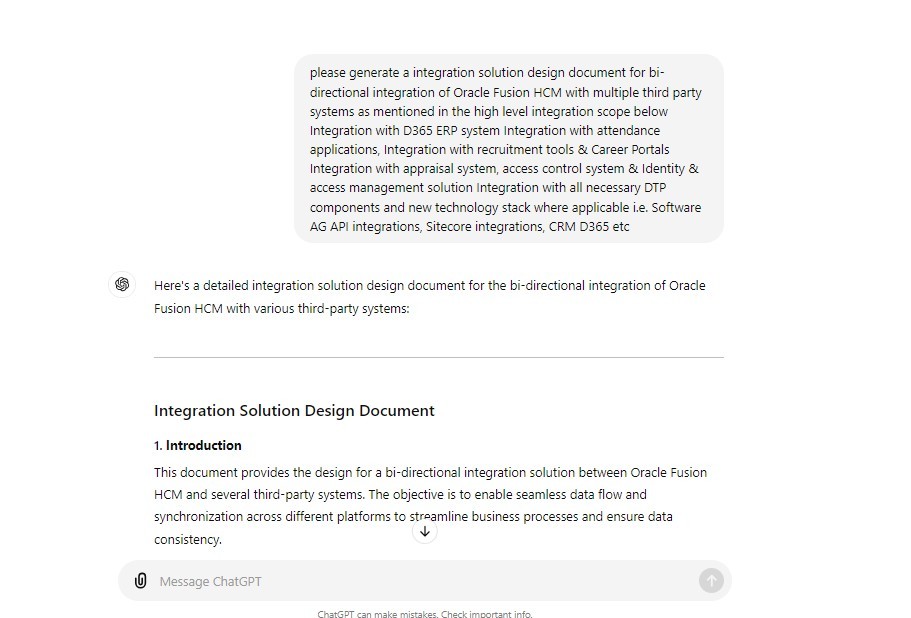
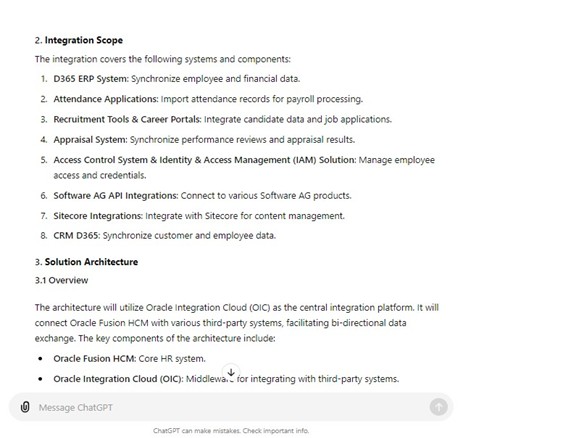
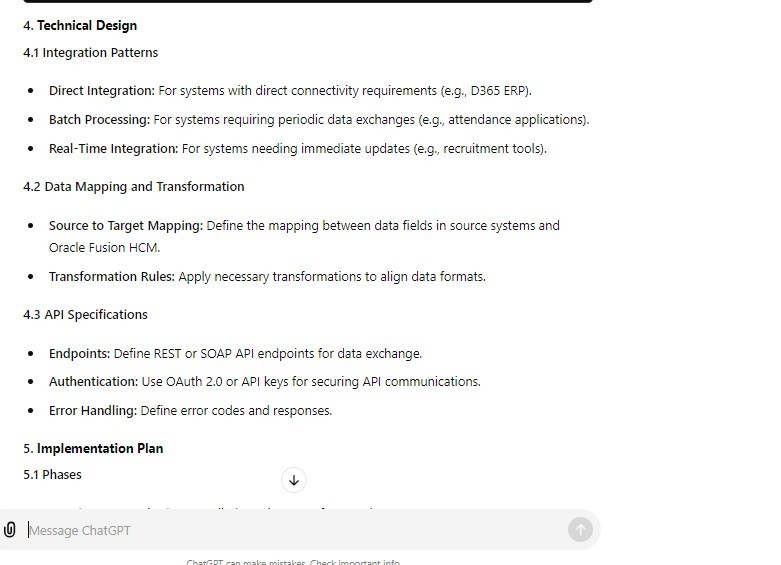
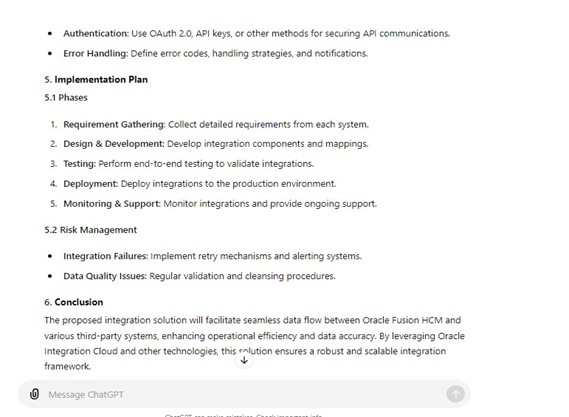
2. Use Case 2: Generating Architecture Diagrams Using ChatGPT to Get Draw.io Script
- ChatGPT generates the script required for creating high-level architecture diagrams using draw.io. The AI model processes integration data and outputs a draw.io script, which is then used to visualize the architecture of the integration solution.
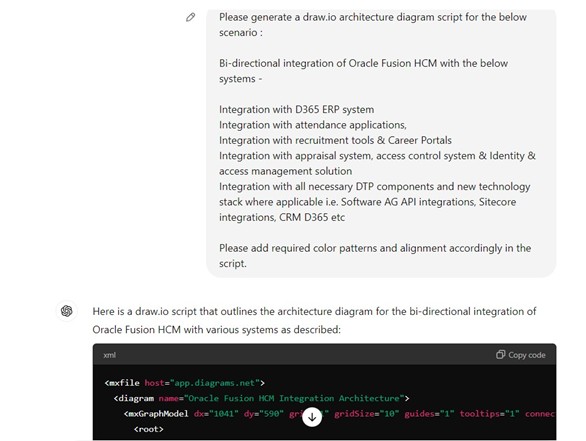
o Response from the draw.io for the script generated by ChatGPT
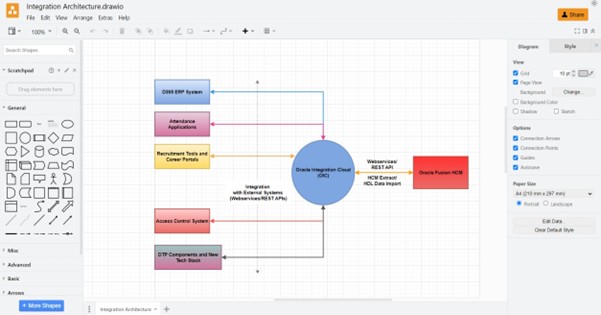
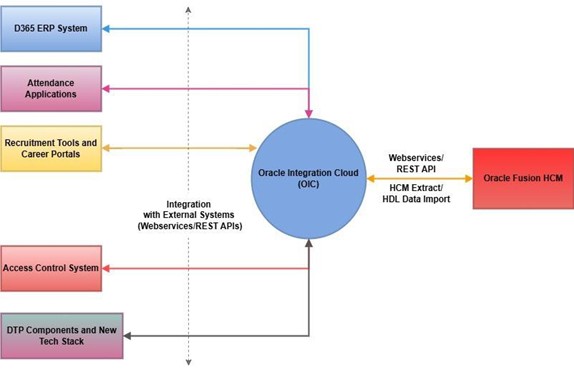
3. Use Case 3: Generating Process Flow Diagrams to Obtain Mermaid Script Using ChatGPT
- In this use case, ChatGPT is employed to generate the Mermaid script necessary for creating process flow diagrams. The AI model provides a script that defines the flow of processes within the integration solution, which is then visualized using Mermaid.

o Response from the mermaid chart for the script generated by ChatGPT
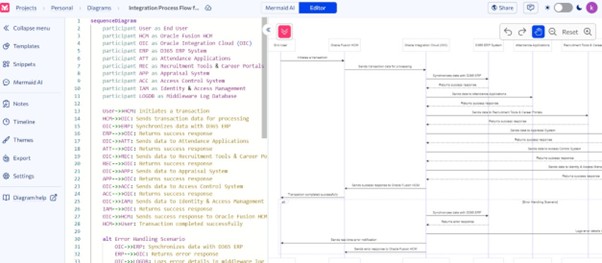
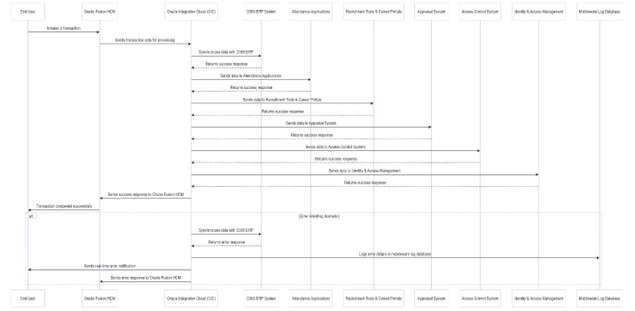
Case Study:
- Challenges: The project required detailed documentation, including a high-level architecture diagram and process flow diagram. Traditionally, this would have been a manual and labour-intensive process, with the risk of misalignment between the documentation and the actual implementation.
- AI–Driven Solution: The project team leveraged AI tools to automate the creation of:
- High-Level Architecture Diagrams: Generated using draw.io, these diagrams depicted the data flow between Oracle ERP, the staging Database, OIC, and Oracle Fusion.
- Process Flow Diagrams: Created using Mermaid flow scripts, these diagrams outlined the step-by-step process of the integration, from data extraction to error handling and notification generation.
- Technical Design Documentation: Drafted using NLP-based AI models, the documentation included detailed descriptions of each integration component, configuration settings, and potential error scenarios.
- Results: The AI-driven approach resulted in:
- Time Savings: The automation reduced the time spent on documentation by over 60%, allowing the integration specialists to focus more on optimizing the solution.
- Improved Accuracy: Automated consistency checks ensured that the documentation accurately reflected the implemented solution, reducing the risk of errors.
- Enhanced Collaboration: The standardized and up-to-date documentation facilitated better collaboration among team members, stakeholders, and clients.
Conclusion
AI-driven tools have proven to be a game-changer in streamlining the creation of integration solution design documentation. By automating the generation of diagrams, technical documents, and consistency checks, companies can save time, reduce errors, and enhance the overall quality of their documentation. As AI continues to evolve, its role in the integration space is expected to grow, further improving efficiency and accuracy in solution design processes.
About the Author
Bala Venkata Kireet is a Technical SOA Consultant with extensive experience in Oracle Integration Cloud and integration solutions. He focuses on optimizing business processes and improving system efficiency.
